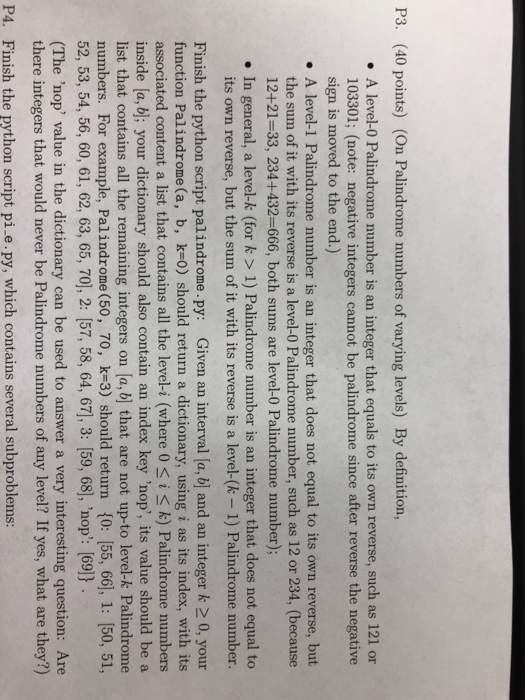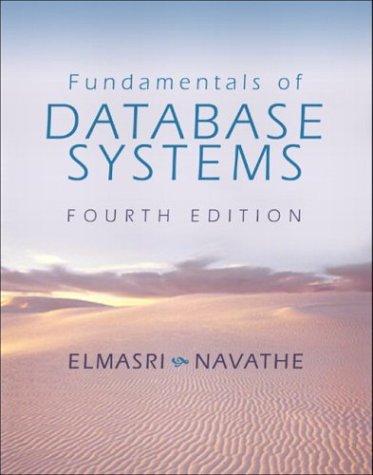Question
# Task: Given two real numbers a # find all the level-i (0 # import math #do not import any other packages def is_Palindrome(n): '''
# Task: Given two real numbers a
# find all the level-i (0
#
import math #do not import any other packages
def is_Palindrome(n):
''' decide if n is a level-0 Palindrome number or not, return True if yes, return False if no '''
def find_level(n, k):
''' decide the appropriate level of n, return i if n is a level-i Palindrome number (0
if n is not a Palindrome number for any level from 0 to k, return k+1
'''
#hint: the logic for the solution is as follows
# loop i from 0 to k,
# if n is of level-i, (do something); if not, (do something else)
# return k+1 if n is not Palindrome of any level from 0 to k
##
##if you prefer not to use the above functions and you have other ways to solve the following
##Palindrome(a, b, k=0) directly, you can code up what you prefer. (The instructor suggests
##using the above two functions is likely the most convenient way to solve this problem.)
##
def Palindrome(a, b, k=0):
''' Find all the level-i Palindrome numbers inside [a, b] for 0
floats and not necessarily integers.
Construct a dictionary, use integer i as its key (i=0, 1, ...k), the value associated with
the key i should be a list that contains all the level-i Palindrome numbers inside [a, b].
This dictinoary should also contain a key 'nop', its associated value should be a list that
contains all the remaining integers in [a, b] that are determined to be non-Palindrome number
for any level from 0 to k. (Make sure integers in each list are in increasing order.)
Return the constructed dictionary.
for example: Palindrome(50.1, 70.2, k=3) should return
{0: [55, 66], 1: [51, 52, 53, 54, 56, 60, 61, 62, 63, 65, 70], 2: [57, 58, 64, 67],
3: [59, 68], 'nop': [69]}.
'''
## do not modify the test code below
if __name__=='__main__':
dict1 = Palindrome(100.1, 150.2, k=5)
#print(dict1)
if dict1[0]!=[101, 111, 121, 131, 141] or \
dict1[1][:12]!=[102, 103, 104, 105, 106, 107, 108, 110, 112, 113, 114, 115] or \
dict1[1][-10:]!=[137, 138, 140, 142, 143, 144, 145, 146, 147, 148] or \
dict1[2]!=[109, 119, 129, 139, 149, 150] or any([dict1[i] != [] for i in [3,4,5,'nop']]):
print(' ***** Test1 failed for palindrome numbers ***** ')
else:
print('Great. Test1 passed for palindrome numbers ')
dict2 = Palindrome(500, 600, k=6)
#print(dict2)
if dict2[0]!= [505, 515, 525, 535, 545, 555, 565, 575, 585, 595] or \
dict2[1][:12]!=[500, 501, 502, 503, 504, 506, 510, 511, 512, 513, 514, 520] or \
dict2[1][-12:]!=[524, 530, 531, 532, 533, 534, 540, 541, 542, 543, 544, 600] or \
dict2[2][-12:]!=[556, 557, 558, 559, 566, 567, 568, 569, 576, 577, 578, 586] or \
dict2[3][-12:]!=[561, 564, 574, 580, 581, 582, 587, 588, 590, 596, 597, 598] or \
dict2[4]!=[539, 570, 571, 579, 591, 599] or dict2[5]!=[549, 562, 572, 594] or dict2[6]!=[] or \
dict2['nop']!=[563, 573, 583, 584, 589, 592, 593]:
print(' ***** Test2 failed for palindrome numbers ***** ')
else:
print('Great. Test2 passed for palindrome numbers ')
dict3 = Palindrome(1900, 2000.9, k=10)
#print(dict3)
if dict3[0]!=[1991] or dict3[1]!=[1900, 1901, 1902, 1903, 1904, 1905, 1906, 1907, 1908, 2000] or \
dict3[2][:12]!=[1909, 1910, 1911, 1912, 1913, 1919, 1920, 1921, 1922, 1923, 1929, 1930] or \
dict3[3][-12:]!=[1955, 1956, 1957, 1958, 1960, 1965, 1966, 1968, 1970, 1974, 1975, 1981] or \
dict3[4]!=[1935, 1944, 1948, 1959, 1961, 1962, 1963, 1982, 1983, 1985, 1989] or \
dict3[5]!=[1936, 1967, 1971, 1973, 1976, 1980, 1990, 1996] or \
dict3[6]!=[1969, 1979, 1986] or dict3[7]!=[1934, 1988, 1992, 1994, 1999] or \
dict3[8]!=[1993, 1995] or dict3[9]!=[1937] or dict3[10]!=[] or \
dict3['nop']!=[1927, 1945, 1946, 1947, 1972, 1977, 1978, 1984, 1987, 1997, 1998]:
print(' ***** Test3 failed for palindrome numbers ***** ')
else:
print('Great. Test3 passed for palindrome numbers ')
## choosing a relatively large k can tell what integers will 'never' be palindrome of any level
## (use even larger k should lead to same returned results)
a=1; b=1000;
dictn = Palindrome(a, b, k=1000)['nop']
#print('your non-palindrome in [{}, {}] of any level={}'.format(a, b, dictn['nop']))
if dictn[:4]!=[196, 295, 394, 493] or dictn[-9:-6]!=[592, 689, 691] or \
dictn[-6:]!=[788, 790, 879, 887, 978, 986]:
print(' ***** Test1 failed for NON-palindrome numbers ***** ')
else:
print('Great. Test1 passed for NON-palindrome numbers ')
a=2000; b=5000;
dictn = Palindrome(a, b, k=1000)['nop']
#print('your non-palindrome in [{}, {}] of any level={}'.format(a, b, dictn['nop']))
if dictn[:5]!=[2494, 2496, 2584, 2586, 2674] or \
dictn[-29:-20]!=[3765, 3853, 3855, 3943, 3945, 3995, 4079, 4169, 4259] or \
dictn[-10:]!=[4709, 4762, 4764, 4799, 4852, 4854, 4889, 4942, 4944, 4979]:
print(' ***** Test2 failed for NON-palindrome numbers ***** ')
else:
print('Great. Test2 passed for NON-palindrome numbers ')

b It vyp 0 e en i nb h hp gte neer nv 7 e] c d5nr n6oe 13 it 3 kt ean f3 nnt 1.1 Ah2 0 4 is u 2 T he b It vyp 0 e en i nb h hp gte neer nv 7 e] c d5nr n6oe 13 it 3 kt ean f3 nnt 1.1 Ah2 0 4 is u 2 T he
Step by Step Solution
There are 3 Steps involved in it
Step: 1

Get Instant Access to Expert-Tailored Solutions
See step-by-step solutions with expert insights and AI powered tools for academic success
Step: 2

Step: 3

Ace Your Homework with AI
Get the answers you need in no time with our AI-driven, step-by-step assistance
Get Started


